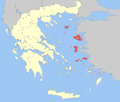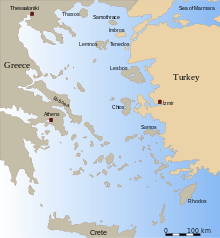Icaria
Icaria, also spelled Ikaria (Greek: Ικαρία), is a Greek island in the Aegean Sea, 10 nautical miles (19 km) southwest of Samos. According to tradition, it derives its name from Icarus, the son of Daedalus in Greek mythology, who was believed to have fallen into the sea nearby.
Icaria Ικαρία | |
|---|---|
 View of Agios Kirykos, Ikaria's capital | |
 Icaria Location within the region 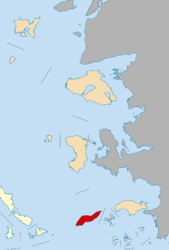 | |
| Coordinates: 37°35′N 26°10′E | |
| Country | Greece |
| Administrative region | North Aegean |
| Regional unit | Ikaria |
| Area | |
| • Municipality | 255.3 km2 (98.6 sq mi) |
| Highest elevation | 1,037 m (3,402 ft) |
| Lowest elevation | 0 m (0 ft) |
| Population (2011)[1] | |
| • Municipality | 8,423 |
| • Municipality density | 33/km2 (85/sq mi) |
| Time zone | UTC+2 (EET) |
| • Summer (DST) | UTC+3 (EEST) |
| Postal code | 833 xx |
| Area code(s) | 22750 |
| Vehicle registration | MO |
Administratively, Icaria forms a separate municipality within the Ikaria regional unit, which is part of the North Aegean region. The principal town of the island and seat of the municipality is Agios Kirykos.[2] The historic capitals of the island include Oenoe and Evdilos.
Geography

Icaria is one of the middle islands of the northern Aegean, 255.303 square kilometres (98.573 sq mi)[3] in area with 102 miles (164 kilometres) of coastline and a population of 8,312 inhabitants. The topography is a contrast between verdant slopes and barren steep rocks. The island is mountainous for the most part. It is traversed by the Aetheras range, whose highest summit is 1,037 metres (3,402 feet). Most of its villages are nestled in the plains near the coast, with some in the mountains.
Icaria has a tradition of producing strong red wine. Many parts of the island, especially the ravines, are covered in shrubbery, making the landscape lush with green. Aside from domestic and domesticated species such as goats, there are a number of small wild animals to be found, such as martens, European otters, jumping spiders, and green toads. Icaria exhibits a typical Mediterranean climate.
History
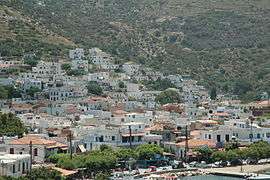
Icaria has been inhabited since at least 7000 BC, when it was populated by the Neolithic pre-Hellenic people of the Pelasgians. Around 750 BC, Greeks from Miletus colonized Icaria, establishing a settlement in the area of present-day Campos, which later became the ancient capital city of Oenoe. Anciently, the island was called Icaria or Ikaria (Ancient Greek: Ἰκαρία), as today; and also Icarus or Ikaros (Ἴκαρος).[4]
Icaria, during the 6th century BC, became part of the sea empire of Polycrates, and during the 5th century BC, the Icarian cities of Oenoe and Thermae were members of the Athenian-dominated Delian League. During the 2nd century, the island was colonized by Samos.[5] At this time, the Tauropolion,[6] the temple of Artemis was built at Oenoe. Coins of the city represented Artemis and a bull.[7] There was another, smaller temenos that was sacred to Artemis Tauropolos,[8] at Nas, on the northwest coast of the island.[9]
Nas had been a sacred spot to the pre-Hellenic inhabitants of the Aegean, and Nas was an important island port in antiquity, the last stop before testing the dangerous seas around Icaria. It was an appropriate place for sailors to make sacrifices to Artemis Tauropolos, who was a patron of seafarers; here, the goddess was represented in an archaic wooden xoanon.
in The Anabasis of Alexander, the second-century Greek historian Arrian recorded Aristobulus as saying that Alexander the Great had ordered that Failaka Island in the Persian Gulf should be called Icarus, after Icaria in the Aegean Sea.[10]
Fate of classical remnants
The temple stood in good repair until the middle of the 19th century when the marble was pillaged, for their local church, by the Kato Raches villagers. In 1939, this church was excavated by the Greek archeologist Leon Politis. During the Axis occupation of Greece during World War II, many of the artifacts that were unearthed by Politis disappeared. Local tales state that Germans stole the artifacts.
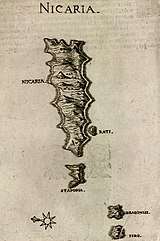
Early modern: Hospitalier and Ottoman era
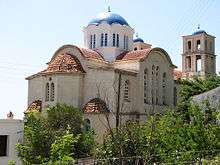
The Knights of St. John, who had their base in Rhodes, exerted some control over Icaria until 1521, when the Ottoman Empire incorporated Icaria into its realm. The Icarians hanged the first Turkish tax collector but managed to escape punishment, since none would identify the guilty one, and the Turks realistically determined that there was neither profit nor honour in punishing all.[11]
The Ottomans imposed a very loose administration, not sending any officials to Icaria for several centuries, although in later years they would appoint groups of locals in each village of the island to act as Kodjabashis in order to collect taxes for the empire. The best account that we have of the island during the early years of the Ottoman rule is from the Archbishop J. Georgirenes, who in 1677 described the island with almost 1,000 hardy, long-lived inhabitants, who were the poorest people in the Aegean.[12]
Without a decent port—the local population destroyed the island's ports long ago to protect themselves from pirate raids—Icaria depended for its very limited intercourse with the outside world upon small craft that were drawn up on the beaches. Icarian boatwrights had a good reputation for building boats from the island's fir forests. Then they sold boats and lumber for coin and grain at Chios. The inshore waters of the island, as told by Georgirenes, provided the best cockle shellfish in the archipelago.
Goats and sheep roamed virtually untended in the rocky landscape. Cheeses were made for consumption in each household. Icaria in the 17th century was unusual in the archipelago in not producing any wine for export. The people kept barrels of the wine for their own drinking. They also continued to store it in the old-fashion way, in terracotta pithoi containers sunk to their rims in earth, thus protected their supplies from both tax collectors and pirates.
Apart from three small towns, none of which exceeded 100 houses,[13] and numerous village settlements, each house had a walled orchard and a garden plot. Unlike the closely built towns of Samos, the hardy inhabitants lived separately in fortified unfurnished farmsteads.
In 1827, during the Greek War of Independence, Icaria broke away from the Ottoman Empire, but was not included in the narrow territory of the original independent Greece, and it was forced to accept Ottoman rule once more a few years later.[14]
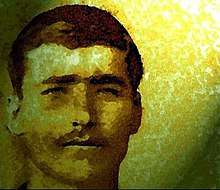
Free State of Icaria
Free State of Icaria Ελευθέρα Πολιτεία Ικαρίας | |||||||||
|---|---|---|---|---|---|---|---|---|---|
| 1912–1912 | |||||||||
 Flag | |||||||||
Anthem: Anthem of Ikaria (Konstantinos Psachos/Fragiskos Carrer)[15] | |||||||||
| Capital | Icaria | ||||||||
| Common languages | Greek | ||||||||
| Religion | Greek Orthodox | ||||||||
| Government | Republic | ||||||||
• President | Ioannis Malachias | ||||||||
| History | |||||||||
• Established | 18 July 1912 | ||||||||
• Disestablished | November 1912 | ||||||||
| |||||||||

Icaria remained part of the Ottoman Empire until 17 July 1912, when the Icarians expelled the Turkish garrison and thereby achieved independence.[14] After its independence and the outbreak of the First Balkan War, Icaria's sole "warship", the Cleopatra, was used to provide food and supplies to the islands of Samos and Chios, which were captured by the Greek Navy during the war. George N. Spanos (c. 1872–1912) of Evdilos, killed in a Turkish ambush on 17 July 1912, is honored as the hero of the Icarian Revolution. His bust, depicting him defiantly, with bandoliers on his body and rifle in hand, may be seen at the memorial established in his honor at the site of his death located in the Icarian town of Chrysostomos.
On 18 July 1912, the Free State of Icaria (Ελευθέρα Πολιτεία Ικαρίας, Elefthéra Politía Ikarías) was declared. The neighboring islands of Fournoi Korseon were also liberated and became part of the Free State. Ioannis Malahias (Ιωάννης Μαλαχίας) was the first and only president of the Free State of Icaria.[14]
For five months, it remained an independent country, with its own government, armed forces, national flag, coat of arms, postage stamps, and national anthem. These five months were difficult for the island's economy. There were food shortages and they were at risk of becoming part of the Italian Dodecanese.[14] In November 1912, after a delay due to the Balkan Wars, Icaria officially became part of the Kingdom of Greece. The Ottoman Empire recognized Greece's annexation of Icaria and the other Aegean islands in the Treaty of London (1913).
Second World War
The island suffered losses in property and lives during the Second World War as the result of the Italian and then German occupation. There are no exact figures on how many people starved, but in the village of Karavostamo alone over 100 perished from starvation.
"Red Rock"
After the ravages of the war the nationalists and communists fought in the Greek Civil War (1946–49), and the Greek government used the island to exile about 13,000 communists. To this date, a number of locals have remained sympathetic to left parties and communism, and, for this reason, Icaria is referred to by some as the "Red Rock" (Κόκκινος Βράχος, Kokkinos Vrahos).
In his analysis, "Rebels and Radicals; Icaria 1600–2000", historian Anthony J. Papalas (East Carolina University) examines modern Icaria in the light of such 20th-century questions as poverty, emigration to America, the nature of the Axis occupation, the rise of Communism, the Greek Civil War, and the rightwing reaction to radical postwar movements.
Modern era
The quality of life improved greatly after 1960, when the Greek government began to invest in the infrastructure of the island to assist in the promotion of tourism. Today, Icaria is considered one of the world's five "Blue Zones" – places where the population regularly lives to an advanced age (one in three make it to their 90s).[16] This is due to healthy diet, lifestyle, and genetics.[17] This was tried to be understood through the Ikaria Study.
Demographics
The inhabitants of the island are known as Icarians or Icariots. (Greek: Ικαριότες, Ikariótes).
An Icarian diaspora is found throughout Greece, specifically on Thimena and Fournoi Korseon, as well as in Athens, where a large community is found. The people of Icarian diaspora can be found throughout the world, mainly in Australia, the United States, Canada, and the United Kingdom.
Icarian Greeks are closely related to other Aegean island Greeks, such as Greeks from Samos, Chios, Fournoi Korseon, and Patmos, as well as Greeks from Anatolia.
Municipality
The present municipality Ikaria was formed in the 2011 local government reform by the merger of the following three former municipalities, that became municipal units:[2]
Subdivisions
The municipal units Agios Kirykos, Evdilos and Raches are subdivided into the following communities (constituent villages in brackets):
Agios Kirykos
- Agios Kirykos (Agios Kirykos, Therma Ikarias, Katafygio, Lardades, Mavrato, Koundouma, Mavrikato, Xylosyrtis, Oxea, Tsouredes, Faros)
- Perdiki (Perdiki, Kioni, Mileopo, Monokampi, Ploumari)
- Chrysostomos (Chrysostomos, Vardarades, Vaoni, Livadi, Plagia)
Evdilos
- Evdilos (Evdilos, Kambos, Agia Kyriaki, Droutsoulas, Kerameio, Kyparissi, Xanthi, Fytema)
- Arethousa (Arethousa, Kyparissi, Pera Arethousa, Foinikas)
- Dafni (Dafni, Akamatra, Kosoikia, Petropouli, Steli)
- Karavostamo
- Manganitis (Manganitis, Kalamonari)
- Frantato (Frantato, Avlaki, Kalamourida, Kampos, Kremasti, Maratho, Pigi, Stavlos)
Raches
- Raches (Christos, Agios Dimitrios, Armenistis, Vrakades, Kares, Nas or Kato Raches, Kouniadoi, Mavriannos, Nanouras, Xinta, Proespera, Profitis Ilias, Tsakades)
- Agios Polykarpos (Agios Polykarpos, Agios Panteleimonas, Gialiskari, Kastanies, Lapsachades, Lomvardades, Mandria)
- Karkinagri (Karkinagri, Amalo, Kalamos, Lagkada, Pezi, Trapalo)
Museums

Archeological Museum of Kampos
The Archaeological Museum, located in the village of Kambos, stands on a hill which was once the ancient fortress of Oinoe, and is immediately next to Agia Irini, Ikaria's oldest church. The museum contains over 250 artifacts, including Neolithic tools, pottery vessels, clay statuettes, columns, coins and carved headstones.
Archeological Museum of Agios Kirikos
Housed in the former lycee of Agios Kirikos, which was built by immigrant Ikarians living in America, the recently renovated neoclassical building dating to 1925 is the home of Ikaria's Archeological Museum as of 2014. This listed building will house all of Ikaria's most relevant finds and highlight the history and culture of the island in the facilities of a modern museum and research/conservation center.
Complete with multimedia displays and films dedicated to the Myth of Ikaros and the ancient citadel of Drakano, the museum presents Ikaria's archeological findings and relates to the visitor an understanding of the cultural, commercial and social development of the settlements of ancient Ikaria throughout the course of the island's history.
Folk & Historical Museum Of Agios Kirikos
Located in Agios Kirikos, The Folk & History Museum of Agios Kirikos in Ikaria was launched in July 2010, and is the result of the long efforts by Professor Themistocles Katsaros. Its mission is to preserve and promote Ikarian folklore, traditions and customs through its display of over 1,500 objects that reflect the history and heritage of Ikaria and its inhabitants. The museum exhibits items of cultural importance from the island, including dresses, textiles, household articles, pottery, agriculture and trade tools & instruments, photos, documents and many other objects.
Of particular interest amongst the items displayed in the museum is the flag of the Free State of Ikaria (1912). Some of the exhibits have been organised thematically and chronologically, so that objects and images give visitors an idea of social and economic life in Ikaria from the 18th century to the 1970s, when traditional life still continued in the region.
Folklore Museum Of Vrakades
The Folklore Museum of Vrakades is located in the scenic village of Vrakades, 650 meters above sea level on the north-western side of the island. The village was founded in the 17th century and contains old stone houses and captains' villas of architectural note. The museum houses an interesting collection of items related to the history and people of the region. Of particular interest are documents and memorabilia from the Free State of Ikaria.
Other exhibits include various clay and wooden objects used by housewives, beekeepers, and farmers, ecclesiastical relics from Profit Elias in Vrakades and the convent of Evagelistrias Mavrianou, books by Ikarian writers, Ikarian records and documents over 500 years old. Of note is the cutter, "lanari" in Greek, used for the processing of wool and goat hairs from which the modest local clothing was made, the "lisgos", a simple tool used for making ropes, an old digging tool, and many other tools belonging to the first inhabitants of the island.
Notable people connected with Icaria
- Eleftheria Arvanitaki (born 1957), singer, originates from Icaria
- Aristides Phoutrides (born 1887), Harvard professor of classical philology
- Aris Poulianos (born 1924), anthropologist, born in Icaria
- Zack Space (born 1961), American politician, family originates from Icaria
- Christodoulos I. Stefanadis (born 1947) professor of cardiology, born on Icaria
- Christodoulos Xiros, (born 1958), Greek terrorist (member of November 17 terrorist group)
References
- "Απογραφή Πληθυσμού - Κατοικιών 2011. ΜΟΝΙΜΟΣ Πληθυσμός" (in Greek). Hellenic Statistical Authority.
- Kallikratis law Greece Ministry of Interior (in Greek)
- "Population & housing census 2001 (incl. area and average elevation)" (PDF) (in Greek). National Statistical Service of Greece. Archived from the original (PDF) on 2015-09-21.
-

- Graham Shipley, A History of Samos, c 800–188 B.C. (Oxford) 1987:205.
- Strabo (xiv.1.19) gives the temple name Tauropolion
- Barclay V. Head, Historia numorum: a manual of Greek numismatics vol. 2, no. 602, with legend ΟΙ or ΟΙΝΑΙ[ΩΝ], noted by Croon 1961:note 4.
- for the aspect of Artemis that was associated with the Tauri, a people living near the Black Sea in the Crimean peninsula, see the article Brauron; that connection underlies the Iphigenia in Aulis of Euripides
- Two sites are distinguished in J. H. Croon, "Hot Springs and Healing: A Preliminary Answer" Mnemosyne, Fourth Series, 14.2 (1961:140–141).
- Arrian (1884) [2nd century AD]. . Translated by Chinnock, E. J. London: Hodder & Stoughton. p. 409 – via Wikisource.
- Georgirenes 1677:
- Joseph Georgirenes, A Description of the Present State of Samos, Nikaria, Patmos, and Mount Athos (London 1677) pp 54–70; Georgirenes is the source for the summary of traditional culture that follows.
- Georgirenes' Cachoria, Steli, famous for its nut trees, and Musara, with its church containing relics of Saint Theoctistes of Lesbos; the Byzantine ruins remained of a larger town than any existing village (Georgirnes 1677:58).
- Anthony J. Papalas (2004). Rebels and Radicals Icaria 1600–2000.
- "βιογραφίες των δημιουργών του". Ikaria News (in Greek). Archived from the original on 30 December 2016. Retrieved 29 December 2016.
- Weekend Edition Saturday. "The Island Where People Live Longer". NPR. Retrieved 2013-03-26.
- Dina Spector (2012-07-13). "Ikaria Greece Longevity Secrets". Business Insider. Retrieved 2013-03-26.
External links
| Wikimedia Commons has media related to Ikaria. |
- "The Island Where People Forget to Die" by Dan Buettner, The New York Times, October 24, 2012
